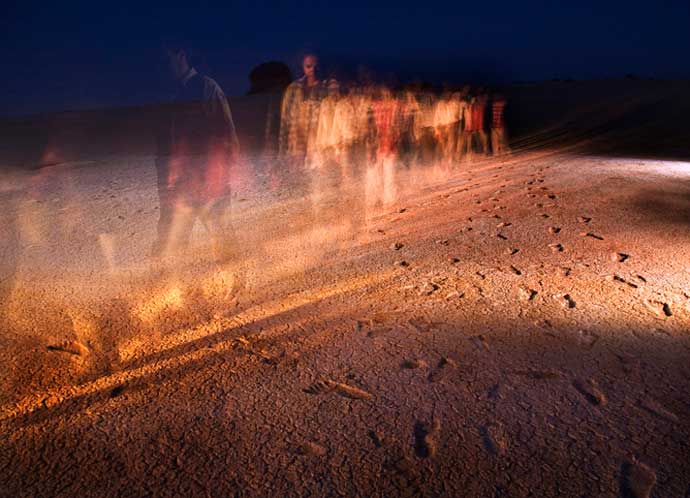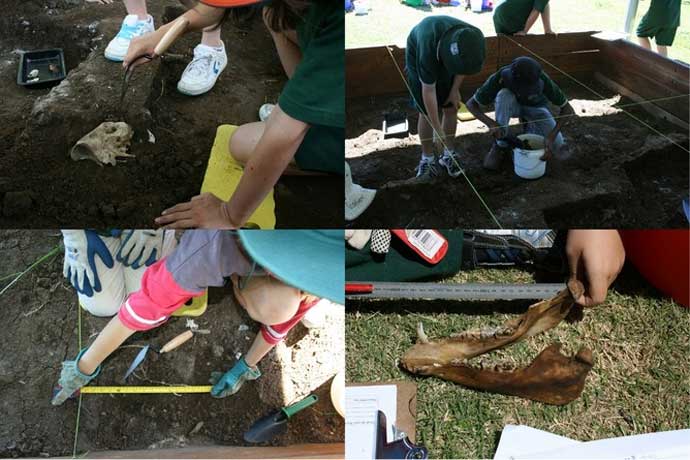Why all Australian kids should learn First Nation peoples history
The archaeological history of the Aboriginal peoples of Australia is a truly remarkable story that very few Australians are aware of ... Perhaps the most deceptive myth perpetuated about Aboriginal society is the idea it was 'primitive', 'stone age', 'nomadic', or 'unevolved'. This type of thinking feeds racist stereotypes and discriminatory attitudes which continue to marginalise and disassociate Aboriginal Australians from the national identity. The archaeology of our continent directly refutes this type of thinking, but until recently the monuments and achievements of ancient Australia have remained largely invisible to the mainstream public.

Traditional Owners and the 20,000 year old Willandra footprints.
Image: Michael Amendolia
Michael Westaway The Conversation 14 March 2014
The national history curriculum implemented across Australia from 2011 provides the opportunity for educators to comprehensively tackle for the first time [1]50,000 years of Australia's history. The future of this innovative new approach to understanding Australian history is potentially threatened by moves from the new government to review the national curriculum.
It is not yet clear how this review might reshape the history curriculum. The Federal Minister for Education has stated that the legacy of Western civilisation needs greater acknowledgement, but what does this mean for the Aboriginal past? There are currently conflicting voices about the relative weighting given to different aspects of Australia's past, but the last [1]50,000 years of Aboriginal history needs to be the start of the Australian story.
Australia's 'Ancient History'
The archaeological history of the First Australians is a truly remarkable story. At a time when Europe was still the domain of Neanderthals, the earliest Aboriginal societies were establishing complex religions, burying their dead with elaborate rituals, engaging in long-distance trade, making jewellery, and producing magnificent works of art. Over the ensuing millennia these societies witnessed huge changes, including the mass extinction of the megafauna and the intense desertification of Australia during the last great Ice Age. They changed and adapted and rose to these significant challenges. They made social and economic choices, developed sustainable ways of living, undertook significant engineering feats and created one of the most unique 'civilisations' in the world.
Unfortunately, very few Australians are aware of this story. It does not easily fit with the colonial mythologies around which popular histories of Australia have traditionally been constructed. Indeed the very use of the term 'civilisation' in relation to Aboriginal Australia will no doubt confound some readers. Perhaps the most insidious myth perpetuated about Aboriginal society is the idea it was 'primitive', 'stone age', 'nomadic', or 'unevolved'. This type of thinking feeds racist stereotypes and discriminatory attitudes which continue to marginalise and disassociate Aboriginal Australians from the national identity. The archaeology of our continent directly refutes this type of thinking, but until recently the monuments and achievements of ancient Australia have remained largely invisible to the mainstream public.
The national history curriculum
Australia's Aboriginal history is a story over [1]50,000 years in the making, but one that has generally been excluded from Australia's school education system. The new curriculum provides significant opportunities for reconfiguring Australia's understanding of Aboriginal history and overturning the legacies of this 'excluded past'.
The benefits for true reconciliation through teaching future generations about the past [1]50,000 years are enormous. The history many of us carry into our adult lives is that which we are taught at school. If the stereotypes around Australia's human past prior to the British settlement in 1788 can be deconstructed, and the archaeological history of Australia placed into its global context, then we will move towards a greater respect for the significant achievements of the First Australians.
The national curriculum takes a chronological approach, and places the world's historical experience in perspective by mapping cultural changes through time.There is no doubt that building a global perspective of humanity's trajectory since the dispersal of modern humans [2] 'Out of Africa' some 60,000 years ago is no small feat. Discussing that story in a classroom context is a challenge, but at the same time an intensely exciting one. Teachers in the classroom will certainly require support and new resources to achieve the aims of the curriculum.
How then do we respond to the new governments proposed changes? Throughout Australia teachers and educators have already begun implementing the new curriculum and are already bringing a new national story to the attention of future generations.

Students undertake a simulated archaeological excavation at Ipswich Primary school.
Courtesy Stephen Nichols
New resources are needed to support the acknowledgement of the deeper Aboriginal past and should extend to investment into sophisticated education and research facilities in landscapes, such as the extraordinary Willandra Lakes World Heritage Area-, that will help connect people to this [1]50,000 year history. The centenary of World War One has seen Australian governments of all persuasions commit millions of dollars into the commemoration of this global tragedy, which gave birth to the Anzac Legend. There is little doubt that it is an important historical event to acknowledge in a meaningful and thoughtful way. The commemoration of 40 years since the discovery of Mungo Man also occurring this year is another important historical event Australians should acknowledge. And this is why the new Australian curriculum is such an important document - it offers a path to new understanding.
Empathy and reconciliation
One of the most important skills promoted by historical inquiry is that of empathy, a feeling of sympathy and engagement for other people from different time periods and cultures. Empathy is a very powerful emotion that helps us recognise and understand diversity. As such it is an important prerequisite for achieving reconciliation in our society. If students can develop the knowledge of why cultures are different it will help develop empathy and encourage an appreciation for diversity, and hopefully, undermine growth of racist viewpoints. Focusing only on the Judeo-Christian account of Australia's heritage reflects an old adage that history is written by the victors. This reduces our capacity for empathy and ultimately deprives us of a more comprehensive appreciation of our humanity.
History should be deeper and further reaching, and responsible education needs to encourage broader appreciation for the diversity of history and culture. In this light the Australian history curriculum is a gallant, bold approach to tackling Australia's place in the global context. It is something that we should work towards embracing. The rewards will be far deeper for future generations of Australians. Of course Western Civilisation is an important part of our history and it has a strong presence in the curriculum. But Australia's history is more than this, and the grand story of the First Australians is an important starting point for a truly Australian narrative.

Students, Elders and archaeologists learning together at the Mungo Youth Conference
Courtesy of the Mungo Youth Project
[1] Now believed to me much longer that 50,000 years - even up to 100,000 years
[2] The 'Out of Africa' theory is not conclusive, nor is the 'Out of Australia, not Africa' theory.
*All content in externally sourced articles is not necessarily the opinion of the Sovereign Union and is included for reference and general information purposes only

